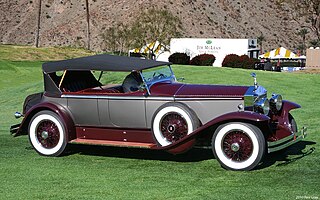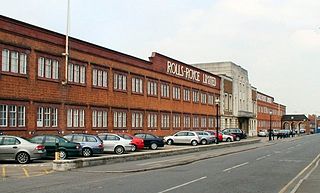
William Vincent Ltd., often known as Vincent of Reading, was a British coachbuilder founded in 1805 making carriages but in 1899 they made their first car body and later made bodies for commercial vehicles.

William Vincent Ltd., often known as Vincent of Reading, was a British coachbuilder founded in 1805 making carriages but in 1899 they made their first car body and later made bodies for commercial vehicles.
The company, initially based in Arborfield, was founded in 1805 building horse-drawn carriages as well as agricultural equipment and railway carriages. They later moved to Castle Street, Reading.
The first car body was built in 1899 and seven years later in 1906 they supplied coachwork for a Rolls-Royce . In the 1920s Vincent claimed to have the "largest and most up-to-date works in the British Isles." [1]

They exhibited at the London Motor Show from 1919 until 1935 making many bodies for Austin and Sunbeam. They became particularly noted however for their horseboxes making the first in 1912 [1] for the Edwardian millionaire racehorse owner, Solomon Joel. Its bodies were particularly noted for their interiors with much use of inlaid woodwork.
When in the 1930s the demand for bespoke coachwork was declining Vincent turned increasingly to commercial vehicle work with horseboxes remaining a speciality.
During World War II the manufacturing site close to Reading station was used to make Spitfire parts. [2]
After World War II the company exhibited again at the Motor Show with a Rolls-Royce displayed from 1948 to 1952. The last carbodies were made in the mid 1950s and the last horsebox in around 1981.
The firm was also an agent for Austin and Rolls-Royce and then BMW. They later became part of the Penta Group of car dealers.

Vanden Plas is the name of coachbuilders who produced bodies for specialist and up-market automobile manufacturers. Latterly the name became a top-end luxury model designation for cars from subsidiaries of British Leyland and the Rover Group, being last used in 2009 to denote the top-luxury version of the Jaguar XJ (X350).

Coupé de ville—also known as town car or sedanca de ville—is a car body style produced from 1908 to 1939 with an external or open-topped driver's position and an enclosed compartment for passengers. Although the different terms may have once had specific meanings for certain car manufacturers or countries, the terms are often used interchangeably.

A coachbuilder or body-maker is a person or company who manufactures bodies for passenger-carrying vehicles. Coachwork is the body of an automobile, bus, horse-drawn carriage, or railway carriage. The word "coach" was derived from the Hungarian town of Kocs. A vehicle body constructed by a coachbuilder may be called a "coachbuilt body" or "custom body".

The Rolls-Royce Phantom IV is a British automobile produced by Rolls-Royce. Only eighteen were made between 1950 and 1956, sold only to buyers whom Rolls-Royce considered worthy of the distinction: the British royal family and heads of state. Sixteen are known to still exist in museums as well as in public and private collections.

The Rolls-Royce Phantom was Rolls-Royce's replacement for the original Silver Ghost. Introduced as the New Phantom in 1925, the Phantom had a larger engine than the Silver Ghost and used pushrod-operated overhead valves instead of the Silver Ghost's side valves.

Brewster & Company was an American custom carriage and motorcar coachbuilder. James Brewster established the company in 1810 which operated for approximately 130 years. Brewster got its start in New Haven, Connecticut, and quickly gained a reputation for producing the best carriages in the country. In 1827, he set his shop at 52 Broad Street in New York City.
Park Ward was a British coachbuilder founded in 1919 which operated from Willesden in North London. In the 1930s, backed by Rolls-Royce Limited, it made technical advances which enabled the building of all-steel bodies to Rolls-Royce's high standards. Bought by Rolls-Royce in 1939, it merged with H. J. Mulliner & Co. in 1961 to form Mulliner Park Ward.

Thrupp & Maberly was a British coachbuilding business based in the West End of London, England. Coach-makers to Queen Victoria they operated for more than two centuries until 1967 when they closed while in the ownership of Rootes Group.

Pressed Steel Company Limited was a British car body manufacturing business founded at Cowley near Oxford in 1926 as a joint venture between William Morris, Budd Corporation of Philadelphia USA, which held the controlling interest, and a British / American bank J. Henry Schroder & Co. At that time the company was named The Pressed Steel Company of Great Britain Limited. It acquired Budd's patent rights and processes for use in the United Kingdom. Morris transferred his interest to his company, Morris Motors Limited.

Rolls-Royce Limited was a British luxury car and later an aero-engine manufacturing business established in 1904 in Manchester by the partnership of Charles Rolls and Henry Royce. Building on Royce's good reputation established with his cranes, they quickly developed a reputation for superior engineering by manufacturing the "best car in the world". The business was incorporated as "Rolls-Royce Limited" in 1906, and a new factory in Derby was opened in 1908. The First World War brought the company into manufacturing aero-engines. Joint development of jet engines began in 1940, and they entered production in 1944. Rolls-Royce has since built an enduring reputation for the development and manufacturing of engines for military and commercial aircraft.

The Quinby was an American automobile manufactured in 1899 in Newark, New Jersey.
The Grose was an English automobile built between 1898 and 1901, Grose also built bodies for cars, buses, ambulances and commercial vehicles until the late 1950s.

Hooper & Co. was a British coachbuilding business for many years based in Westminster London. From 1805 to 1959 it was a notably successful maker, to special order, of luxury carriages, both horse-drawn and motor-powered.

James Young Limited was a top class British coachbuilding business in London Road, Bromley, England.

The Cunard Motor & Carriage company was a British vehicle coachbuilder. It was founded in London in 1911 and continued in various forms up to the 1960s.

J Gurney Nutting & Co Limited was an English firm of bespoke coachbuilders specialising in sporting bodies founded in 1918 as a new enterprise by a Croydon firm of builders and joiners of the same name. The senior partner was John (Jack) Gurney Nutting (1871–1946).

Freestone and Webb were English coachbuilders who made bodies for Rolls-Royce and Bentley motor cars but also built bodies on other chassis including Alfa Romeo, Packard, and Mercedes-Benz.

Barker & Co. was a British coachbuilder, a maker of carriages and in the 20th century bodywork for prestige cars, including Rolls-Royce, Bentley, and Daimler.

The Carlton Carriage Company was a London coachbuilder that provided bespoke coachwork for some of the finest car makers of the 1920s and 1930s. They are best known for their drophead coupes which are archetypal designs of the British Jazz Era.